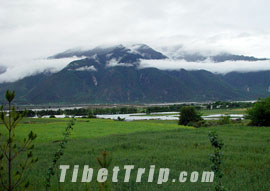 Most people think of Tibet as synonymous with dizzying altitudes, stark landscapes, and harsh climates. However, its southeastern part, an area covering 117,000 sq km (45,174 sq miles), is exceptionally mild and fertile. The area is known as 'Tibetan Jiangnan', which means those regions to the south of the Yangtze River. The Tibetans refer to the area as, 'the throne of the sun', in what outsiders know as the Nyingchi Region.
Most people think of Tibet as synonymous with dizzying altitudes, stark landscapes, and harsh climates. However, its southeastern part, an area covering 117,000 sq km (45,174 sq miles), is exceptionally mild and fertile. The area is known as 'Tibetan Jiangnan', which means those regions to the south of the Yangtze River. The Tibetans refer to the area as, 'the throne of the sun', in what outsiders know as the Nyingchi Region.
At an average altitude of 3,000m (9,843 ft), Nyingchi is located in the lower reaches of the Yarlung Tsangpo River , bordering India and Burma to the south and Yunnan Province to the east. Here the world highest river wends its way south toward the Indian Ocean after it meets the Himalayas, which, together with the Hengduan Mountains and the Nyainqentanglha Mountains, majestically encompasses the Nyingchi Region. This sharp turn not only forms the world largest canyon, but also brings the warm monsoons of the Indian Ocean. This geographic anomaly creates a uniquely temperate and humid climate of the region, as well as an amazing combination of snow-capped mountain ranges and a verdant sea of forests.
As China's third largest forested region, Nyingchi covers 80% of the forest resources in Tibet and contains a number of natural reserves, such as the Pemako National Fauna and Flora Reserve, Dzayul Rare Fauna and Flora Reserve and Pagqi Huge Cypress Nature Reserve . A rich diversity of over 3,500 plants, from snow lotuses on the mountain peaks to palm trees along the Great Canyon of the Yarlung Tsangpo River, is naturally presented. More than 100 wildlife species, including Bengal tigers, pangolins, red-chested parrots, boas and yakins, are under the national protection. In addition to the Yarlung Tsangpo River and its branches, which give Nyingchi abundant water resources, a considerable distribution of lakes, glaciers and waterfalls makes the region full of breathtaking examples of spectacular natural wonders.

Once called 'Kongpo' (presently named Nyingchi County, Miling County and Kongpo Gyamda County), it has a history of over 4,000 years and its culture--called the Nyingchi Culture by historians--is quite distinctive from the mainstream of Tibetan culture. Except for various festivals that are celebrated differently from other Tibetan areas, as one of the places where the Bon religion originated, Nyingchi is also featured by a dense flavor of the indigenous religion of Tibet. Moreover, 10% of its population (200,000 in total) is represented by more than 10 non-Tibetan ethnic groups, such as the Menpa, Luopa, Naxi, Dulong, and Deng, among others. Interestingly, the Menpa and the Luopa people still carry on their primitive but unique customs in the deepest part of the Great Canyon.
![]() Related Link: Map of the Tibet Railway Scenery
Related Link: Map of the Tibet Railway Scenery








